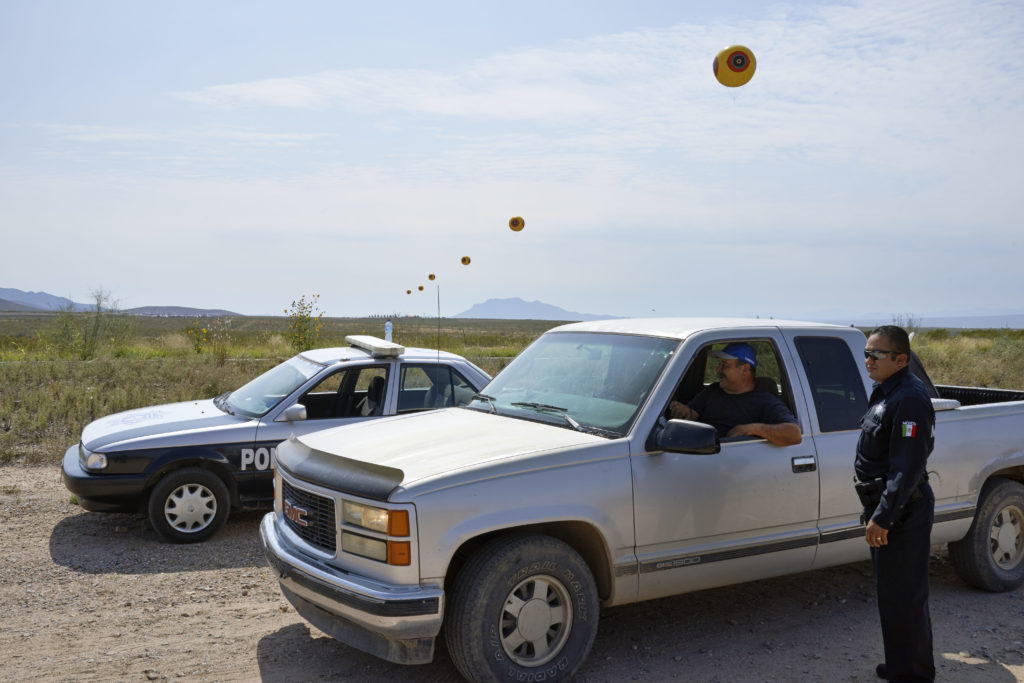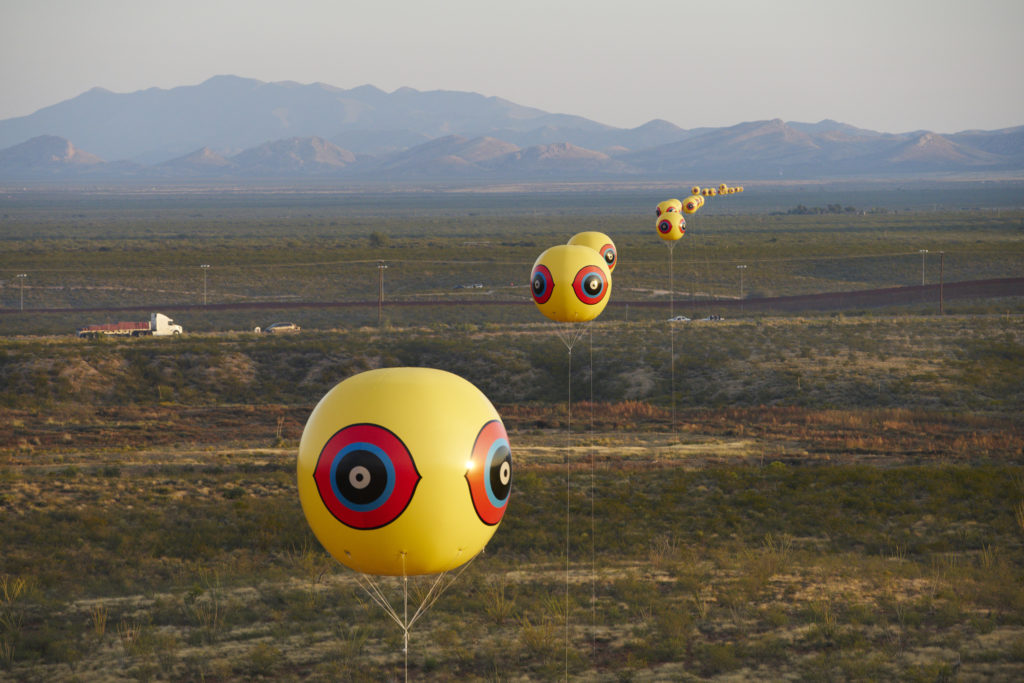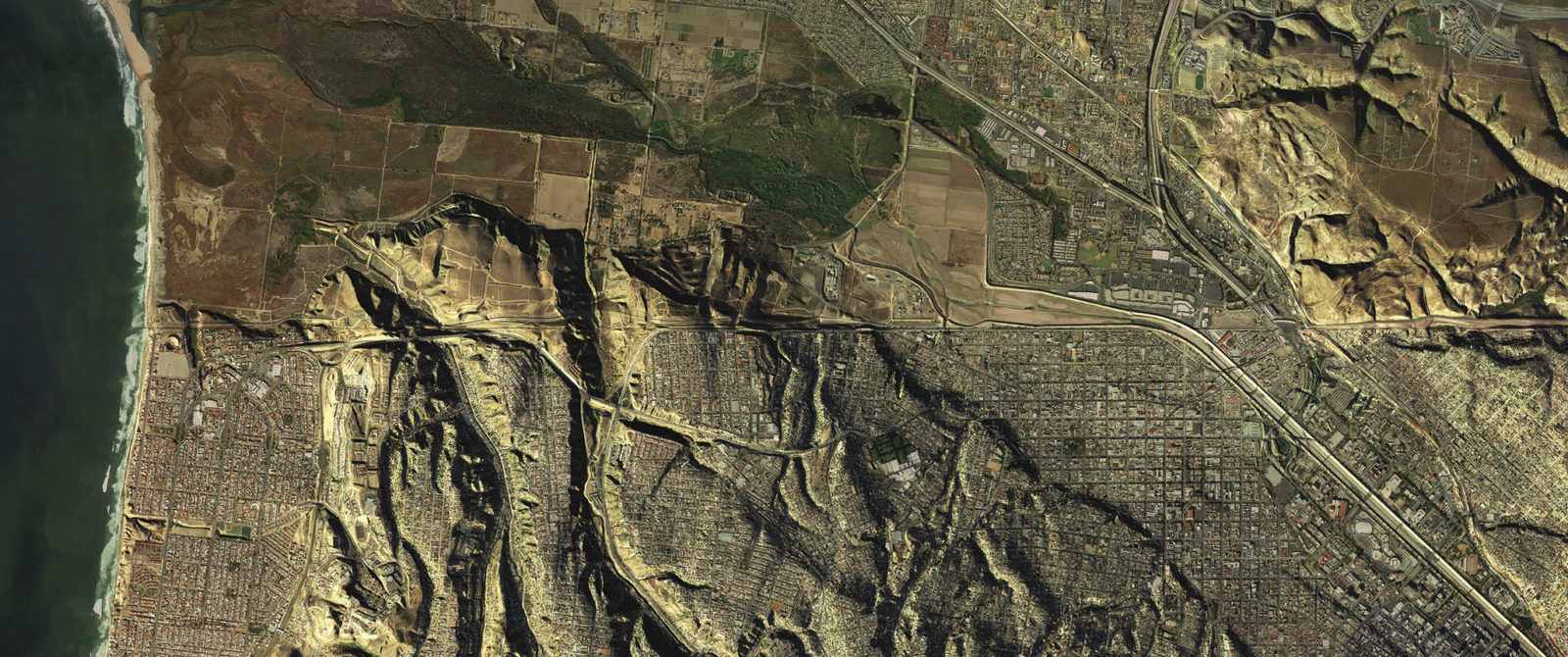Beyond, Between, and Under the Border: Navigating the Carceral State
by Hiba Ali

A border is nothing but a man-made fiction, imagined and realized by those who would never be imprisoned within its bounds. To colonizers, borders were pure cartography—settling matters after beating the enemy. With pen to paper, business was conducted, and a deal was made. To Europeans, North America was seen as property; a barren land meant for conquering, and resources meant to be extracted. This geography was not always known as the United States of America—and to many it still is not. Rather, to the many Indigenous communities that continue to reside within it, the US has encroached upon Turtle Island.1
Some call the US-Mexico border, La linea.2 Gloria Anzaldúa calls it, La frontera,3 Calle 13 has called the journey, Pa’l Norte (Heading North),4 and the current sitting president has called people who come from it rapists, criminals, and gangs. In terms of movement, most Indigenous communities are not ‘settled’—their relationship to the land, its animals, and plants is symbiotic. As early as 1785, Indigenous communities were forced to sign treaties that favored US interests. While the National Anthem claims “the land of the free and the home of the brave,” we must ask: who is really ‘free’ on stolen land? On land stolen from Indigenous people, toiled upon by enslaved black people, whose railroads were forcibly built by Chinese people, and is now home of the biggest incarceration rate in the world?5 On land that is a hub for separating children from their parents at its borders, where ICE can set up secret checkpoints within a 100-mile radius to detain and deport people without regulation or oversight.6
Zoé Samudzi and William C. Anderson state in What Lands On Us—an excerpt from their 2018 book, As Black as Resistance— that, “…settler colonialism is a far more invasive mode of colonialism that is marked by the ‘dispensability’ of Indigenous communities. It is a ‘project whose dominant feature is not exploitation but replacement,’ driven by a ruling logic of a ‘sustained institutional tendency to eliminate the Indigenous population. Settler invasion is a structure, not an event.’”7 The colonization of America was structured and organized—it was planned. Just as the separation of families was also callously organized. In his 1975 book, Discipline and Punish, Foucault calls this phenomenon a carceral archipelago. The term ‘carceral’ refers to prisons, while ‘archipelago’ refers to the cluster of systems, i.e. networks used to patrol, surveil, police, and punish. In 2018, it serves to note that the US border is carceral.89
Southwestern states—namely Texas, California, and New Mexico—were once a part of Mexico. But before that, they were the sole settlements of different Indigenous nations who lived back and forth throughout the region. The US-Mexico border is a man-made convention, finalized in 1853, yet the communities that have resided upon this geography have always been porous.10
Artist collective Postcommodity’s Repellent Fence (2015) installation strikes at the root of this convention, highlighting the continued connection of Indigenous communities despite the border. Floating 100 feet above the desert landscape near the US-Mexico border—installed between the town of Douglas, Arizona, and Agua Prieta, Sonora—26 tethered yellow balloons are installed across two miles. Postcommodity—a trio comprised of artist and composer Raven Chacon, artist and scholar Cristóbal Martínez, and interdisciplinary artist Kade L. Twist—worked with local community collaborators in both cities throughout the process of Repellent Fence.11 The yellow balloons are ten feet in diameter, and feature Indigenous medicine colors of yellow, red, white, black, and blue with iconography of the shape of oblong concentric circles known as the ‘open eye.’ The inspiration of the balloon is an appropriated readymade from a product meant to deter birds— of this appropriation, Postcommodity states, “Indigenous ways of being and Indigenous byproducts have been rationalized by European colonizers of the Americas as instruments of repulsion for more than 500 years. This historical narrative and discourse are embedded in each scare-eye balloon.”12 In the installation, the balloons’ iconography casts a gaze across the land, reminding us of the integral connection of Indigenous peoples. As writer Carolina Miranda states, Repellent Fence serves to “provide long-form historical evidence of the cultural exchanges that have taken place through trade, intermarriage, migration, and warfare.”13

Yet, the work begs the question: what does the Repellent Fence repel? In 2018, the context of the piece pushes back on the colonial, genocidal logic of gross simplification that separates Indigenous communities by the side of the border on which they happen to be.
The call to recognize the interconnection of the region explored in Postcommodity’s work is similarly heralded by architect, Teddy Cruz, and political scientist, Fonna Forman, whose project, MEXUS—featured at the US Pavilion’s exhibition, Dimensions of Citizenship, at the 2018 Venice Architecture Biennale—complicates and challenges the notion of belonging associated with citizenship.14 In 2011, the duo led three hundred people through a pipe that connects San Diego to Tijuana, negotiating with US and Mexican border patrol from both sides. The pipe connects waterways of a US estuary with the higher elevated Los Laureles canyon in Mexico; this drainage channel is “integrated into the current border wall [and has] accelerated the movement of waste.”15 As a part of MEXUS, Cruz and Forman highlight the interdependence of the region’s waterways by mapping eight watersheds, mountain ranges, rivers, drainages, and estuaries whose 2,000-mile outline resembles a dragon, with San Diego as the head and Brownsville, Texas, the tail. Focusing on the “greater San Diego-Tijuana region to share and gather data for a cross-border study [regarding civic attitudes and amend problematic ones]…their goal is to better understand common values shared by inhabitants in one of the largest binational metropolitan areas in the world.”16 Ultimately, this project highlights the common values and ideals of both cities, recalling the region’s fluidity.
The region’s imbricated layers also feature prominently in the recent exhibition Young Latinx Artists 23: Beyond Walls, Between Gates, Under Bridges, which opened this year at the Mexic-Arte Museum in Austin, Texas. Here, artist Evelyn Contreras’ Untitled (2017) installation features glow-in-the-dark, LED-lined architectural meshes, screen printed onto mirrored acrylic. Simultaneously inviting yet ominous, the installation is an allusion to the invitation of ‘better dreams’ associated with immigrating to the United States. Inspired by low-rider Chicano culture lexicon of So-Cal, Contreras terms the architectural tessellations with pink and purple edges, “a fake space,” where viewers can project onto the space that which they want to see, riddled with bias and assumptions. To her, the oft-spouted “border wall” represents the unknown. As the artist states, “People are afraid of the unknown. If you live in a tiny town in which you never were exposed to different people with different backgrounds, you will perpetually see them as ‘other.’ If you have news validating the ‘other’ ideology, you are going to agree on the ‘wall.’ The wall represents fear and nostalgia for a more transparent white supremacist society.”17
The question is, how many people who have privilege in a white supremacist society are willing to give it up for others?
The perils of the border wall are more figuratively imaged in Abel Saucedo’s acrylic painting on wood, entitled Tunnel Runner part 2 of 2 (2017). A man’s head sticks out from above the ground, behind him is a wall with a Mexican flag on top of it. Viewers do not know if he is coming or going; he is stuck in a place of liminality. Scholar Homi Bhabha describes this liminality as a border zone in itself, it “refers to a transitory, in-between state or space, which is characterized by indeterminacy, ambiguity, hybridity, potential for subversion and change. As a transitory space, it foregrounds the temporal border and in narrative is often associated with life-changing events or border situations.”18 The tunnel could lead to freedom or cartels, construction or sewage. We as viewers cannot tell, and Saucedo does not provide any clues—instead, the artist moves us to make eye contact with the subject and engage with the figure’s humanity.
What mass media terms an immigrant crisis is actually a refugee crisis. This is just one residue of the United States’ interference into Latin America since the mid-1800s, as the region was regarded as a “sphere of influence” in the minds of politicians, supported by the Monroe Doctrine, and in competing with European powers that made this intervention constitutionally permissible. Historic turmoil, US-centric trade agreements, and coup d’états have wreaked havoc on these economic and social structures. If people want to survive, they have no other option but to go elsewhere. People send young children by themselves across the border only so they can have a fighting chance; people get on rickety boats only when being on water is safer than land, people only take La Bestia—a train notorious for unsafe conditions and murders—when there are no other options left.19 Postcommodity echoes this, “The US-Mexico ‘immigration crisis’ is, in fact, a human rights crisis of the Western Hemisphere, driven by irresponsible neoliberal trade practices, resource extraction, development, and labor practices of multinational corporations.”20

The sentiment for historic and continued injustice is echoed by artist and activist collective, R.I.S.E.—Radical Indigenous Survivance & Empowerment—and its founder, Demian DinéYazhi´. DinéYazhi´ is a Diné (Navajo) artist born to the clans Tódích´íí´nii (Bitter Water) and Naasht´ézhí TábÄ?Ä?há (Zuni Clan Water’s Edge) who was raised in Gallup, New Mexico and is currently based in Portland, Oregon. Their exhibition, A Nation Is a Massacre at Pioneer Works, which ran from May–July, 2018, “considers over 500 years of mass shootings and massacre, missing and murdered Indigenous womxn, queers, transgender gradient/ nonconforming, and two spirit folx, and numerous instances of environmental racism/injustice that continue to be ignored by citizens of a colonized country.”21 Throughout the duration of the exhibition, a Risograph was used to generate posters, zines, and physical ephemera that feature political aphorisms, slogans, wall-based montages, and activist agitprop. For the exhibition, a poster entitled Lincoln Ordered the Greatest Mass Hanging In America’s History (2016) features a portrait of President Lincoln and a news article with a headline, in red block letters over a field of green color, calling out the vociferous ignorance of the genocidal history of settler colonialism in America. For DinéYazhi, the use of red is “a political gesture of Indigenous presence” and the portrait of Abraham Lincoln, the 16th American president remembered for the abolition of slavery is iconic— pointing out that the history of erasure and genocidal atrocities are at the inception to the early years of this country, covered by the guise of American nationalism and ‘freedom.’22
According to manuel arturo abreu, DinéYazhi´’s work embodies the concept of survivance, defined by Anishinaabe scholar Gerald Vizenor as “an active sense of presence, the continuance of native stories, not a mere reaction, or a survivable name. Native survivance stories are renunciations of dominance, tragedy and victimry.”23
Indigenous stories are an integral part of the Americas; they cannot be erased. Those who reside in a settler-colonial state such as the United States must recognize the continued history of erasure of Indigenous communities—both within the country and also those who come as refugees. If the Indigenous communities of the Americas were heard, the historical injustices in the face of their continued trauma and disenfranchisement could change. Indigenous communities that were historically erased by state sponsored genocide would be given a chance to shape the present and future as they see fit, survivance writ large. Current and future generations could live in a world where settler colonialism and imperialism no longer define the framework of existence, in a space where, perhaps, the United States does not exist.
Young Latinx Artists 23: Beyond Walls, Between Gates, Under Bridges, guest curated by Rocha-Rochelli at Mexic-Arte Museum in Austin, TX, ran from June 15–August 26, 2018.
- Kurt, Miighan. “Turtle Island: The Original Name for North America.” La Malinche – Indian Women In History. March 29, 2007. Accessed July 13, 2018.
- Jaramillo, Ann. La Linea/ the Line. Roaring Book Press, 2006.
- Anzaldúa, Gloria. Borderlands = La Frontera. San Francisco: Aunt Lute Books, 1999.
- Calle13VEVO. YouTube. October 25, 2009. Accessed July 11, 2018.
- Lee, Michelle Ye Hee. “Does the United States Really Have 5 Percent of the World’s Population and One Quarter of the World’s Prisoners?” The Washington Post. April 30, 2015. Accessed July 13, 2018.
- ACLU. “The Constitution in the 100-Mile Border Zone.” American Civil Liberties Union. Accessed August 01, 2018.
- Samudzi, Zoé, and William C. Anderson. “What Lands On Us.” The New Inquiry. June 05, 2018. Accessed July 11, 2018.
- Shenk, Timothy. “Booked: The Origins of the Carceral State.” Dissent Magazine. August 30, 2016. Accessed July 13, 2018.
- Foucault, Michel. Discipline And Punish. Pantheon Books, 1977.
- Wallenfeldt, Jeff. “How the Border Between the United States and Mexico Was Established.” Encyclopædia Britannica. Accessed July 13, 2018.
- Postcommodity. “Repellent Fence.” Postcommodity: Repellent Fence—2015. 2015. Accessed July 11, 2018.
- Native Arts and Cultures Foundation. “Repellent Fence: Art That Engages Communities through Collaboration.” Native Arts and Cultures Foundation. November 29, 2017. Accessed July 13, 2018.
- Miranda, Carolina A. “A Border Fence Made of Air: Native Artists to Create Two-mile Balloon Installation.” Los Angeles Times. September 18, 2015. Accessed July 13, 2018.
- U.S. Pavillion. “Dimensions of Citizenship.” Dimensions of Citizenship. March 19, 2018. Accessed July 13, 2018.
- Miranda, Carolina A. “A New U.S.-Mexico Border? At the Venice Biennale, Imagining a Binational Region Called MEXUS.”
- Ibid.
- Evelyn Contreras, Interview, 2018.
- Border Poetics Project. “Border Poetics —Liminality.” Liminality—Border Poetics. Accessed July 12, 2018.
- Sayre, Wilson. “Riding ‘The Beast’ Across Mexico To The U.S. Border.” NPR. June 05, 2014. Accessed July 12, 2018.
- Art Matters/Postcommodity. “Postcommodity.” Art Matters Foundation. 2012. Accessed July 11, 2018.
- DinéYazhi´, Demian. “A Nation is a Massacre.” BURY MY ART AT WOUNDED KNEE. May 24, 2018. Accessed July 12, 2018.
- DinéYazhi´, Demian, Interview, 2018.
- Vizenor, Gerald Robert. Manifest Manners: Narratives on Postindian Survivance. Lincoln, Neb.: Univ. of Nebraska Press, 1999, p. vii